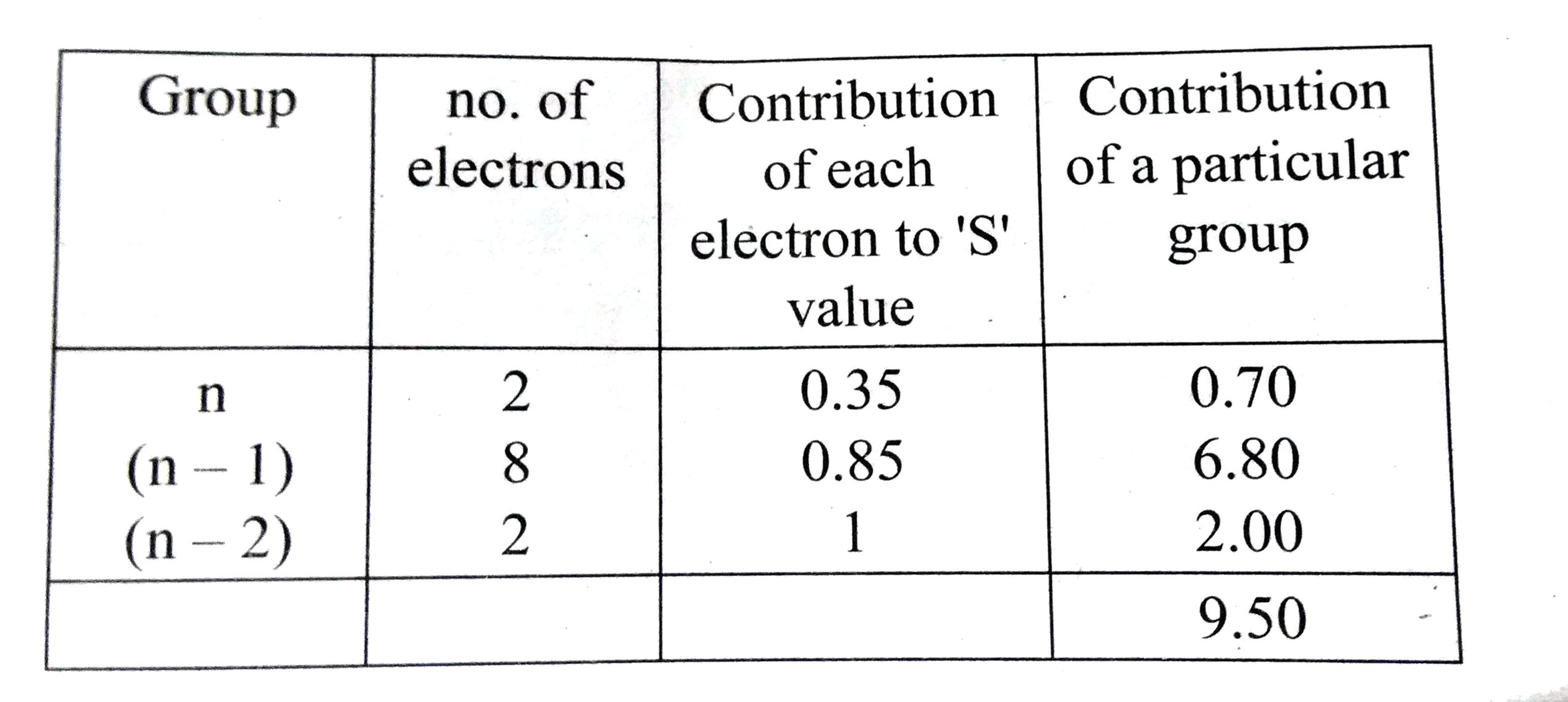Using Slater's rule calculate the effective nuclear charge on a 3p electron in aluminium and chlorine .Explain how these results relate to the atomic radii of the two atoms.Solution in Tamil
Al131s2(n−2)2s22p6(n−1)3s23p1(n)

∴ Effective nuclear change =Z-S=13-9.5
(Zeff)Al=3.5
Electronic Configuration of chlorine
1s2(n−2)2s22p6(n−1)3s23p5(n)

∴ Effective nuclear charge =Z-S=17=10.9
(Zeff)Cl=6.1
(Zeff)Cl>(Zeff)Al and hence rCl<rAl
Topper's Solved these Questions
- PERIODIC CLASSIFICATION OF ELEMENTS BOOK - FULL MARKSCHAPTER - PERIODIC CLASSIFICATION OF ELEMENTS EXERCISE - Additional Questions(M.C.Q)
38 Videos
- PERIODIC CLASSIFICATION OF ELEMENTS BOOK - FULL MARKSCHAPTER - PERIODIC CLASSIFICATION OF ELEMENTS EXERCISE - Additional Questions(Match the follwing)
5 Videos
- PERIODIC CLASSIFICATION OF ELEMENTS BOOK - FULL MARKSCHAPTER - PERIODIC CLASSIFICATION OF ELEMENTS EXERCISE - Textual Evaluation Solved( II brief question)
24 Videos
- HYDROGEN BOOK - FULL MARKSCHAPTER - HYDROGEN EXERCISE - Additional Questions Solved 5-Mark Questions
10 Videos
- PHYSICAL AND CHEMICAL EQUILIBRIUMBOOK - FULL MARKSCHAPTER - PHYSICAL AND CHEMICAL EQUILIBRIUMEXERCISE - ADDITIONAL QUESTIONS SOLVED (NUMERICAL PROBLEMS)
3 Videos
Similar Questions
The law of triads is not obeyed by
View SolutionMatch the following columns

View SolutionDefine modern periodic law.
View SolutionExplain about the different industrial preparation of hydrogen.
View SolutionFind the value of Kc for each of the following equilibria from the value of Kp
(a) 2NOCl(g)⇔2NO(g)+Cl2(g),KP=1.8×10−2 atm at 500 K
(b) CaCO3(s)⇔CaO(s)+CO2(g),KP=167 atm at 1073 K
View SolutionCalculate the effective nuclear charge of the last electron in an atom. The electronic configuration is 1s^(2), 2s^(2)2p^(6), 3s^(2)3p^(5) .
View SolutionCalculate the effective nuclear charge at the periphery of nitrogen atom when an extre electron is added in the formation of anion . Also calculate the effective nuclear charge of N-atom.
View SolutionThe effective nuclear charge on the added electron in F-atom , in the formation of negative ion is
View SolutionAccording to Slater's Rule effective nuclear charge of Na is x and of K is y respectively. Calculate value of x - y = ?
View SolutionEffective nuclear charge on last electron of Fe^(2+) (Using Slater's Rule)
View SolutionJ.C. Slater proposed an empirical constant that represents the cumulative extent to which the other electrons of an atom shield (or screen) any particular electron from the nuclear charge. Thus, slater's screening contant sigma is as : Z^(**)=Z-sigma Here, Z is the atomic number of the atom, and hence is equal to the actual number of protons in the atom. the parameter Z^(**) is the effective nuclear charge, which according to is smaller than Z, since the electron in question is screened (shielded) from Z by an amount sigma . Conversely, an electron that is well shielded from the nuclear charge Z experiences a small effective nuclear charge Z^(**) . The value of sigma for any one electron in a given electron configuration (i.e., in the presence of the other electrons of the atom in question) is calculated using a set of empirical rules developed by slater. according to these rules, the value of sigma for the electron in question is the cumulative total provided by the various other electrons of the atom. Q. Which of the following statement is correct?
View SolutionCalculate the effective nuclear charge experienced by the 4s electron in potassium atom .
View SolutionCalculate the effective nuclear charge of the last electron in an atom whose configuration is 1s^(2)2s^(2)2p^(6)3s^(2)3p^(5)
View SolutionCalculate the effective nuclear charge experienced by the 4s electron in potassium atom.
View SolutionCalculate the effective nuclear charge experienced by the 4s electron in potassium atom.
View Solution
